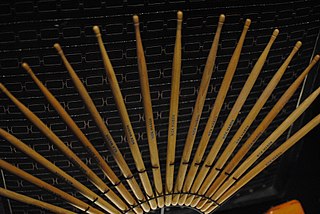
A cymbal is a common percussion instrument. Often used in pairs, cymbals consist of thin, normally round plates of various alloys. The majority of cymbals are of indefinite pitch, although small disc-shaped cymbals based on ancient designs sound a definite note. Cymbals are used in many ensembles ranging from the orchestra, percussion ensembles, jazz bands, heavy metal bands, and marching groups. Drum kits usually incorporate at least a crash, ride, or crash/ride, and a pair of hi-hat cymbals. A player of cymbals is known as a cymbalist.

A drum kit is a collection of drums, cymbals, and sometimes other auxiliary percussion instruments set up to be played by one person. The drummer typically holds a pair of matching drumsticks or special wire or nylon brushes; and uses their feet to operate hi-hat and bass drum pedals.

A hi-hat is a combination of two cymbals and a pedal, all mounted on a metal stand. It is a part of the standard drum kit used by drummers in many styles of music including rock, pop, jazz, and blues. Hi-hats consist of a matching pair of small to medium-sized cymbals mounted on a stand, with the two cymbals facing each other. The bottom cymbal is fixed and the top is mounted on a rod which moves the top cymbal toward the bottom one when the pedal is depressed.
The ride cymbal is a cymbal of material sustain used to maintain a beat in music. A standard in most drum kits, the ride's function is to maintain a steady pattern, sometimes called a ride pattern, rather than provide the accent of a crash cymbal. It is normally placed on the extreme right of a drum set, above the floor tom. It is often described as delivering a "shimmering" sound when struck soundly with a drumstick, and a clear ping when struck atop its bell.

A gong is a percussion instrument originating from Southeast Asia, and used widely in Southeast Asian and East Asian musical traditions. Gongs are made of metal and are circular and flat or bowl-like in shape, and can come in various sizes. They are typically struck with a mallet. They can be played alone, giving a characteristic "crashing" sound, or played as part of a tuned set that produce bell-like sounds.
Cymbals are made from four main alloys, all of them copper-based. These are: bell bronze, malleable bronze, brass, and nickel silver.
Modern cymbal making comprises many different techniques, from traditional hand methods to completely automated mass-production.

In western music, a China cymbal is a distinct type of crash cymbal designed to produce a bright, crisp, and explosive tone that has brought it the nickname trash cymbal. The name "China cymbal" comes from its shape, which is similar to that of the Chinese Bo. Such cymbals are most frequently mounted upside down on cymbal stands, allowing for them to be more easily struck and for a better sound.
In a drum kit, splash cymbals are the smallest accent cymbals, often a smaller derivative of the more common crash cymbals. Splash cymbals and china cymbals are the main types of effects cymbals.

An effects cymbal is a cymbal used in a drum kit for a special effect or accent. Effects cymbals include splash cymbals, china cymbals and many other less common types.
In cymbal making, taper refers to the gradual change in thickness from the bell to the rim of the cymbal. It is one of the key features that determines the tone of the cymbal.

The swish cymbal and the pang cymbal are exotic ride cymbals originally developed and named as part of the collaboration between Gene Krupa and the Avedis Zildjian Company. The current Zildjian Swish Knocker is a redesign of their original swish, with more rivets, deeper bow and shallower bell, based on a cymbal made famous by Mel Lewis, who coined the name knocker.

Paiste is a Swiss musical instrument manufacturing company. It is the world's third largest manufacturer of cymbals, gongs, and metal percussion. Paiste is an Estonian and Finnish word that means "shine".

A bell cymbal, bell splash cymbal, or ice bell is a small, very thick cymbal with little if any taper, used as an effects cymbal in a drum kit. The sound produced when striking the bell cymbal with a drumstick is a distinctive high-pitched ping sound with a long sustain. Some manufacturers list bell cymbals as a type of splash cymbal, others as a distinct type.

Drum hardware is the set of parts of a drum or drum kit that are used to tension, position, and otherwise support the instruments themselves.

A drum stick is a type of percussion mallet used particularly for playing snare drum, drum kit, and some other percussion instruments, and particularly for playing unpitched percussion.

A rattle is a percussion beater that is attached to or enclosed by a percussion instrument so that motion of the instrument will cause the rattle to strike the instrument and create musical sound.
Heavy metal drumming is a style of rock music drum kit playing that developed in the late 1960s and early 1970s, largely in the United States and the United Kingdom. With roots in blues rock and psychedelic/acid rock drum playing, heavy metal drummers play with emphatic beats, and overall loudness using an aggressive performing style. Heavy metal drumming is traditionally characterized by emphatic rhythms and dense bass guitar-and-drum sound.
















